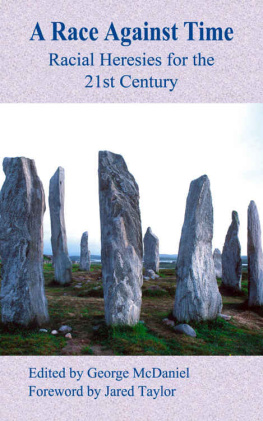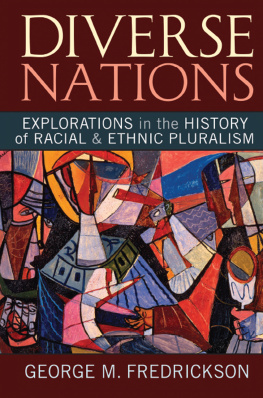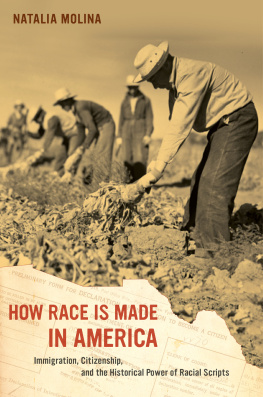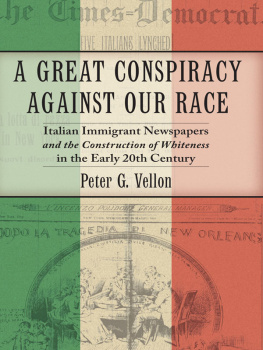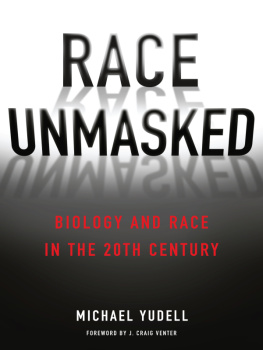A Race Against Time
Racial Heresies for the 21st Century
Edited by
George McDaniel
Foreword by
Jared Taylor
New Century Foundation
Other titles from New Century Books:
Jared Taylor, Ed., The Real American Dilemma: Race, Immigration, and the Future of America, 1998
Michael Levin, Why Race Matters: Race Differences and What They Mean, 2005
Carleton Putnam, Race and Reason: A Yankee View, 2006
Samuel T. Francis, Essential Writings on Race, 2007
Steven Farron, The Affirmative Action Hoax: Diversity, the Importance of Character, and Other Lies (Second Edition), 2010
Jared Taylor, White Identity: Racial Consciousness in the 21st Century, 2011
Jared Taylor, Paved With Good Intentions: The Failure of Race Relations in Contemporary America (20th Anniversary Kindle Edition, 2014, based on First Carroll & Graf Edition, 1992)
Published daily on the Internet:
American Renaissance
www.amren.com
Copyright 2014 by New Century Foundation
All rights reserved.
This Kindle edition is based on the First New Century Books Edition, Copyright 2003 by New Century Foundation.
New Century Books
Box 527
Oakton, Virginia 22124-0527
Tel. (703) 716-0900
Fax (703) 716-0932
Cover: Callanish Stones on the Scottish island of Lewis in the Hebrides. The megaliths were erected 5,000 years ago to form a circle and several avenues. The tallest is just over 15 feet high. The stones were abandoned around 800 BC, and had nearly disappeared beneath the peat when they were excavated in the mid-19th century.
Photo by Charles Tait
Kindle edition prepared by John Vawter
To Glayde Whitney
1939 2002
Contents
Notes on the Kindle Edition
This text is based on the First New Century Books Edition, Copyright 2003 by New Century Foundation. It includes minor corrections and is current as of July 10, 2014.
The print edition contains a few page footnotes, some of which include content as well as any citations. These notes have been collected and placed at the end of each chapter.
Tables present a problem on e-readers. The tables in this book have been formatted to be as narrow as possible for maximum compatibility, but if a table appears truncated on the right margin or if its distorted by line wraps, please reduce the font size to compensate.
Each table contains a link that moves the table to the top of the current page, so that a maximum amount of data is visible on a single page. This is intended to prevent a table from spanning two pages.
Foreword
by Jared Taylor
O n March 10, 2003, two policemen died in a shootout at the Stapleton Houses in New York City. Grace Watkins, who lives in the virtually all-black housing project, explained that when people learned of the killings they said the policemen got what they deserved. I think a lot of people out here werent worried about [the shootings], she explained, because they thought they were white cops, but when they heard the cops were black, their attitude changed totally, and they started expressing concern for the police officers families.
Grace Watkins is 18 years old, which means she was born 20 years after the landmark civil rights legislation of the 1960s. Since well before the 1980s, every pillar of American society has passionately supported the goal of eliminating racial prejudice. For her entire life, people of Miss Watkins race have not only been legally protected from discrimination but have benefited from the preference programs we call affirmative action. Our country has invested more moral energy in the fight against racism than in any national undertaking since the Second World War. And yet, nearly 40 years after the crowning achievements of the civil rights struggle, Miss Watkins calmly tells a reporter that her black friends and acquaintances were unconcerned by the deaths of two men they assumed were white. The policemen became human beings in their minds only when they turned out to be black.
Miss Watkins comments were just a touch of atmosphere to liven up a routine crime story. No doubt most readers soon forgot about her. But what Grace Watkins saidand the silence that greeted itare symbols of the almost complete failure of the colossal effort our country has made to transform race relations. Grace Watkins does not live in the America the activists of the civil rights movement promised us. None of us does.
The goal of integration, of eliminating racial prejudice, of dismantling racial barriers was to build a society in which race would lose its significance. We were, in Martin Luther Kings now almost scriptural terms, to judge each other by the content of our character and not by the color of our skin. Grace Watkins friends certainly judge people by the color of their skin. Although whites do not usually express themselves quite so freely, they often do the same.
Americans still separate themselves by race. Residential neighborhoods are almost as segregated as they were in the 1960s. Church congregations are segregated. Generation after generation, school children fail the lunch-room test by sitting with friends of their own race. If they ever stop to think about it, Americans know that the constant cheerleading for integration and diversity only masks deep divisions. Outside of a few pockets of self-conscious mixing, Americans generally live their lives among people like themselves.
Occasionally, the country goes through a spasm of self-righteousness, in which someone pretends to take the old civil-rights vision seriously. Does anyone remember President William Clintons racial initiative? Launched with great fanfare during his second term, it was supposed to be the cornerstone of his legacy. It would set the country back upon the road to racial harmony and become the basis for buildingto use the initiatives full nameOne America in the 21st Century.
The very fact of the initiative was a recognition that race relations are not as we had expected. Its name even implied that racial conflict threatens the idea of one America. And yet, despite all the power and prestige of the White House, the initiative achieved nothing. Perhaps not even Mr. Clinton himself would claim it accomplished anything. What was to carve a presidents name into history has disappeared without a trace. Like hundreds of other race initiatives, outreach programs, commissions, and blue-ribbon panels, it was a futile exhalation of hot air.
The only interesting thing about this failure was that, like so many before it, it in no way dimmed the official goal of establishing an America in which race does not matter. We still celebrate Martin Luther King Day, we still muster fury on an Inquisitional scale for blasphemers like Trent Lott, we still mouth platitudes about the glories of diversitybut are there any real believers left? Does anyone still think blacks can be taught to do as well in school as whites, that the ghettos will become middle class, that whites will stay when blacks or Mexicans move in, that racial tension will disappear, or that the national unity we took for granted in the 1940s and 1950s can survive bilingualism, multiculturalism, and the reduction of whites to a minority?
We have become like the Soviet Union, where a classless utopia continued to be the official national goal, even though everyone knew it was impossible. Our racial myths may have been propounded with the best intentions but they are as mistaken and corrupting as Marxist economics. Nations cannot be built in pursuit of unobtainable goals, and on principles in which almost no one believes.

